Lockheed C-141 Starlifter Video - Overview
|
|
Lockheed C-141 Starlifter
C-141 Starlifter
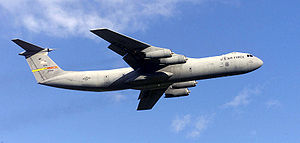
Picture - A USAF C-141C
Role: Strategic airlifter
Manufacturer: Lockheed
First flight: 1963
Introduced: 1965
Retired: 5 May 2006
Primary user: United States Air Force
Produced: 1963-1968
Number built: 285
The Lockheed C-141 Starlifter was a military strategic airlifter in service with the Air Mobility Command (AMC) of the United States Air Force. The aircraft also served with AMC-gained airlift wings and air mobility wings of the Air Force Reserve Command (AFRC) and the Air National Guard (ANG) and, in later years, one air mobility wing of the Air Education and Training Command (AETC) dedicated to C-141, C-5, C-17 and KC-135 training.
Introduced to replace slower piston-engined cargo planes such as the C-124 Globemaster II, the C-141 was designed to requirements set in 1960 and first flew in 1963. Production deliveries of an eventual 285 planes began in 1965: 284 for the Air Force, and one for the National Aeronautics and Space Administration (NASA) for use as an airborne observatory. The aircraft remained in service for almost 40 years until the USAF withdrew the C-141 from service on 5 May 2006, replacing the aircraft with the C-17 Globemaster III.
Design and development
In the early 1960s, the United States Air Force Military Air Transport Service (MATS) relied on a substantial number of propeller-driven aircraft for strategic airlift. As these aircraft were mostly obsolescent designs and the Air Force needed the benefits of jet power, the USAF ordered 48 Boeing C-135 Stratolifters as an interim step. The C-135 was a useful stop-gap, but only had side-loading doors and most bulky and oversize equipment would not fit, especially that employed by the U.S. Army.
In the spring of 1960 the Air Force released Specific Operational Requirement 182, calling for a new aircraft that would be capable of performing both strategic and tactical airlift missions. The strategic role demanded that the aircraft be capable of missions with a radius of at least 3,500 nmi (4,000 mi, 6,500 km) with a 60,000 lb (27,000 kg) load. The tactical role required it to be able to perform low-altitude air drops of supplies, and carry and drop paratroops in combat. Several companies responded to SOR 182, including Boeing, Lockheed and General Dynamics.
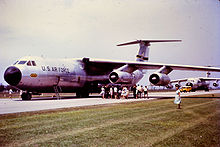
Picture - Early C-141As of 436th Airlift Wing, MAC, at Brisbane Airport, Australia supporting the visit of President Lyndon B. Johnson, 22 October 1966.
Lockheed responded to the requirement with a unique design: the Lockheed Model 300, the first large jet designed from the start to carry freight. The Model 300 had a swept high-mounted wing with four 21,000 lbf (93.4 kN) thrust TF33 turbofan engines pod-mounted below the wings. An important aspect was the cabin floor's height of only 50 in (1.27 m) above the ground, allowing easy access to the cabin through the rear doors. The two rear side doors were designed to allow the aircraft to drop paratroopers (in August 1965 the type performed the first paratroop drop from a jet-powered aircraft). The rear cargo doors could be opened in flight to allow airborne freight drops. The shoulder-mounted wings gave internal clearance in the cargo hold of 10 ft (3.05 m) wide, 9 ft (2.74 m) high and 70 ft (21.34 m) long. The size enabled the Starlifter to carry, for example, a complete LGM-30 Minuteman intercontinental ballistic missile in its container. The aircraft was capable of carrying a maximum of 70,847 lb (32,136 kg) over short distances, and up to 92,000 lb (41,730 kg) in the version configured to carry the Minuteman, which stripped other equipment. The aircraft could also carry up to 154 troops, or 123 fully-equipped paratroopers.
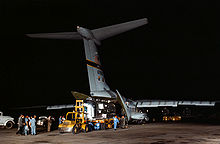
Picture - The Apollo 11 Mobile Quarantine Facility is unloaded from a C-141 at Ellington Air Force Base, July 27, 1969.
President John F. Kennedy's first official act after his inauguration was to order the development of the Lockheed 300 on 13 March 1961, with a contract for five aircraft for test and evaluation to be designated the C-141. One unusual aspect of the aircraft was that it was designed to meet both military and civil airworthiness standards. The prototype C-141A serial number 61-2775 was manufactured and assembled in record time, being rolled out of the Lockheed factory at Marietta, Georgia on 22 August 1963 and first flying on 17 December, the 60th anniversary of the Wright brothers' first flight. The company and the Air Force then started an operational testing program and the delivery of 284 aircraft, initially to units of the MATS, later renamed the Military Airlift Command (MAC) in 1966.
An effort to sell the aircraft on the civilian market resulted in provisional orders from Flying Tiger Line and Slick Airways for four aircraft each. These were to be a stretched version, 37 ft (11.28 m) longer than the C-141A, and marketed as the L-300 SuperstarLifter. Other changes were also incorporated to make more commercial including a different yoke. The development was not sustained and only one civilian demonstration aircraft was built. When no commercial sales were made Lockheed donated the aircraft to NASA.
Operational history
The prototype and development aircraft then began an intensive operational testing program including the first delivery to MATS (63-8078) on 19 October 1964 to the 1707th Air Transport Wing, Heavy (Training), Tinker Air Force Base, Oklahoma. Testing continued and a Federal Aviation Authority type certificate was awarded on 29 January 1965. The first delivery to an operational unit (63-8088) was made on 23 April 1965 to the 44th Air Transport Squadron, 1501st Air Transport Wing, Travis Air Force Base, California. Although operational testing continued, due to the U.S.'s military involvement in South Vietnam, the C-141 was soon employed in operational sorties to the combat zone.
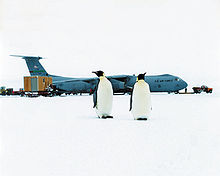
Picture - C-141 participating in Operation Deep Freeze
On 16 September 2004, the C-141 left service with nearly all active duty USAF units, being confined to Air Force Reserve and Air National Guard units for the remainder of its operational service life. As of 25 September 2005, there were only eight C-141 aircraft still flying, all from the Air Force Reserve's 445th Airlift Wing (445 AW) at Wright-Patterson AFB. In 2004, 2005, and 2006, the C-141s assigned to the 445 AW participated in missions to Iraq and Afghanistan, mostly for the medical evacuation of wounded service members. The last eight C-141s were officially retired in 2006 (see below).
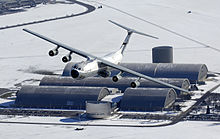
Picture - Hanoi Taxi flying over the National Museum of the United States Air Force in December 2005.
In 2002 one of the last operational aircraft at Wright-Patterson AFB was identified by its crew chief as the Hanoi Taxi (AF Serial Number 66-0177), one of the aircraft used in 1973 for Operation Homecoming in the final days of the Vietnam War, to repatriate American POWs from North Vietnam.
In 2005, Hanoi Taxi and other aircraft were marshalled by the Air Force to provide evacuation for those seeking refuge from Hurricane Katrina. This aircraft and others evacuated thousands of people, including the medical evacuation (MEDEVAC) of hundreds of ill and injured.
With the 2006 announcement of the retirement of these last eight C-141s, the Hanoi Taxi embarked on a series of flights, giving veterans, some of whom flew out of POW captivity in Vietnam in this aircraft, the opportunity to experience one more flight before retirement. On 6 May 2006, the Hanoi Taxi landed for the last time and was received in a formal retirement ceremony at the National Museum of the United States Air Force, located at Wright-Patterson Air Force Base in Riverside, Ohio near Dayton.[1]
Variants
C-141A
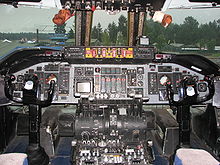
Picture - Cockpit of early C-141 on display at McChord AFB
The original Starlifter model, designated C-141A, could carry 154 passengers, 123 paratroopers or 80 litters for wounded with seating for 16. A total of 284 A-models were built. The C-141A entered service in April 1965. It was soon discovered that the aircraft's volume capacity was relatively low in comparison to its lifting capacity; it generally ran out of physical space before it hit its weight limit. The C-141A could carry ten standard 463L master pallets and had a total cargo capacity of 62,700 lb (28,900 kg). It could also carry specialized cargoes, such as the Minuteman missile.
NASA obtained Lockheed's C-141 demonstrator, designated L-300. The airplane was modified to house the Kuiper Airborne Observatory telescope for use at very high altitudes. This NASA NC-141A is now in storage at NASA Ames Research Center, Moffett Federal Airfield, CA.
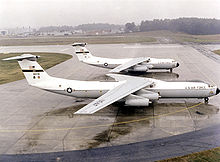
Picture - A lengthened C-141B in front of a C-141A
C-141B
In service, the C-141 proved to "bulk out" before it "massed out", meaning that it often had additional lift capacity that went wasted because the cargo hold was too full. To correct the perceived deficiencies of the original model and utilize the C-141 to the fullest of its capabilities, the entire fleet of 270 in-service C-141As were stretched, adding needed payload volume. The conversion program took place between 1977 and 1982, with first delivery taking place in December 1979. These modified aircraft were designated C-141B. It was estimated that this stretching program was equivalent to buying 90 new aircraft, in terms of increased capacity. Also added was a boom receptacle for inflight refueling. The fuselage was stretched by adding "plug" sections before and after the wings, lengthening the fuselage a total of 23 ft 4 in (7.11 m) and allowing the carriage of 103 litters for wounded, 13 standard pallets, 205 troops, 168 paratroopers, or an equivalent increase in other loads.
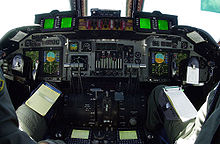
Picture - The upgraded glass cockpit of the C-141C variant
SOLL II
In 1994, a total of 13 C-141Bs were given SOLL II (Special Operations Low-Level II) modifications, which gave the aircraft a low-level night flying capability, enhanced navigation equipment, and improved defensive countermeasures. These aircraft were operated by AMC in conjunction with Air Force Special Operations Command (AFSOC). These aircraft were replaced by the C-17.
C-141C
A total of 63 C-141s were upgraded throughout the 1990s to C-141C configuration, with improved avionics and navigation systems, to keep them up to date until C-17s were available to replace them. This variant introduced some of the first glass cockpit technology to the aircraft, as well as improving reliability by replacing some mechanical and electromechanical components with their electronic equivalents.
Operators
United States
United States Air Force - 284 C-141A, B and C
1501st Air Transport Wing, (MATS), 1965-1966
Re-designated: 60th Air Mobility Wing Travis AFB, California, 1966-1997
62d Airlift Wing
McChord AFB, Washington, 1966-2002
63d Airlift Wing
Norton AFB, California, 1967-1994
315th Airlift Wing
Charleston AFB, South Carolina, 1993-2001
349th Air Mobility Wing
Travis AFB, California, 1969-1998
1607th Air Transport Wing, (MATS), 1965-1966
Re-designated: 436th Airlift Wing Dover AFB, Delaware, 1966-1973
1608th Air Transport Wing, (MATS), 1965-1966
Re-designated: 437th Airlift Wing Charleston AFB, South Carolina, 1966-2000
438th Airlift Wing
McGuire AFB, New Jersey, 1967-1994
1707th Air Transport Wing, (MATS), 1964-1966
Tinker AFB, Oklahoma Re-designated: 443d Airlift Wing Altus AFB, Oklahoma, 1966-1992
445th Airlift Wing
Wright-Patterson AFB, Ohio, 1994-2006
446th Airlift Wing
McChord AFB, Washington, 1973-2000
459th Airlift Wing
Andrews AFB, Maryland, 1986-2003
512th Airlift Wing
Dover AFB, Delaware, 1973
514th Air Mobility Wing
McGuire AFB, New Jersey, 1968 - 2004
NASA - 1 C-141A Construction Number 300-6110. Did not receive a USAF serial number, was flown with civil registration N4141A and later as NASA N714NA. Operated 1966-1995
Accidents
On 12 July 1984, Immediately after takeoff from Sigonella NAS on the Italian island of Sicily, the aircraft’s number 3 engine experienced an uncontained failure. Debris was ejected and caused number 4 engine to also fail. Debris also entered the cargo compartment, starting a fire in a pallet containing paint. The cargo fire produced thick poisonous smoke which made visual control of aircraft extremely difficult. The aircraft entered a steep bank and crashed within 198 seconds of takeoff. All 8 crewmen and 1 passenger on board were killed. Post crash toxicology indicated the crew had received potentially fatal levels of cyanide poisoning from the smoke, prior to impact. Subsequent to this accident, smoke goggles were added to crew oxygen masks.
On 13 September 1997, a Luftwaffe Tu-154M (ex-East German Air Force) collided in mid-air at cruising altitude with a USAF C-141 off the African coast near Namibia. All crew 24 on the Tu-154 plus the 9 crew on the C-141 were killed.
Survivors
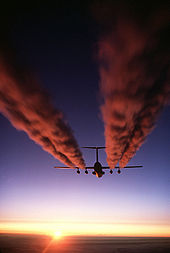
Picture - A C-141 Starlifter leaves a vapor trail over Antarctica
C-141A (AF Serial No. 61-2775) Is the first C-141A produced and is on display at the Air Mobility Command Museum at Dover Air Force Base, Delaware
C-141B (AF Serial No. 64-0626) is on display at the Air Mobility Command Museum at Dover Air Force Base, Delaware
C-141B (AF Serial No. 65-0257) is on display at the March Field Air Museum, March Air Reserve Base, in Riverside, California
C-141B (AF Serial No. 65-0236) participated in Operation Homecoming returning POWs from Hanoi. On display at the Scott Field Heritage Air Park at Scott Air Force Base near Belleville, Illinois
C-141C (AF Serial No. 67-0166) The last C-141 built; previously served as an aircraft for CINCMAC, COMAMC and CDRUSTRANSCOM. Currently at Scott Air Force Base near Belleville, Illinois (not on display at this time)
C-141C (AF Serial No. 66-0177) "Hanoi Taxi" is on display at the National Museum of the United States Air Force at Wright-Patterson Air Force Base in Dayton, Ohio
C-141C (AF Serial No. 65-0248) is on display at the Museum of Aviation at Robins Air Force Base in Houston County, Georgia
C-141B (AF Serial No. 63-8088) is on display at Travis Air Force Base in Fairfield, California. Nicknamed "The Golden Bear," it was the first C-141 delivered to Travis AFB.
C-141B (AF Serial No. 63-8079) is on display at the Charleston AFB Air Park at Charleston Air Force Base in Charleston, South Carolina
C-141B (AF Serial No. 66-7947) "Garden State Airlifter" is on display at McGuire Air Force Base, New Jersey
C-141B (AF Serial No. 65-0277) is on display at the McChord Air Museum, McChord Air Force Base, in Tacoma, Washington.
C-141B (AF Serial No. 65-9400) is on display next to the control tower at Altus Air Force Base, Oklahoma
C-141B (AF Serial No. 67-0013) is on display at the Pima Air and Space Museum adjacent to Davis-Monthan Air Force Base in Tucson, Arizona
C-141A used by NASA (NASA-714) as the Kuiper flying observatory. This aircraft is in storage at the NASA Ames Research Center, Moffett Federal Airfield, California.
Specifications (C-141B Starlifter)
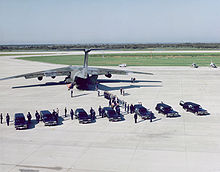
Picture - A MAC C-141 transport plane takes the remains of the crew of STS-51-L to Dover Air Force Base, Delaware.
Data from
General characteristics
Crew: 5-6
Length: 168 ft 4 in (51.3 m)
Wingspan: 160 ft 0 in (48.8 m)
Height: 39 ft 3 in (12 m)
Wing area: 3,228 ft˛ (300 m˛)
Empty weight: 144,492 lb (65,542 kg)
Max takeoff weight: 342,100 lb (147,000 kg)
Powerplant: 4x— Pratt & Whitney TF33-P-7 turbofans, 20,250 lbf (90.1 kN each) each
Performance
Maximum speed: 567 mph (493 kn, 912 km/h)
Range: 2,935 mi (2,550 nmi, 4,723 km)
Ferry range: 6,140 mi (5,330 nmi, 9,880 km) unrefueled
Service ceiling: 41,000 ft (12,500 m)
Rate of climb: 2,600 ft/min (13.2 m/s)
Wing loading: 100.1 lb/ft˛ (490 kg/m˛)
Thrust/weight: 0.25
Strategic airlift
Related development
C-5 Galaxy
Comparable aircraft
C-17 Globemaster III
Ilyushin Il-76
Johnsen, Frederick A. Lockheed C-141 Starlifter. North Branch, Minnesota: Specialty Press, 2005. ISBN 1-58007-080-9.
Lockheed C-141 Starlifter Pictures and Lockheed C-141 Starlifter for Sale.
Living Warbirds: The best warbirds DVD series.
Source: WikiPedia